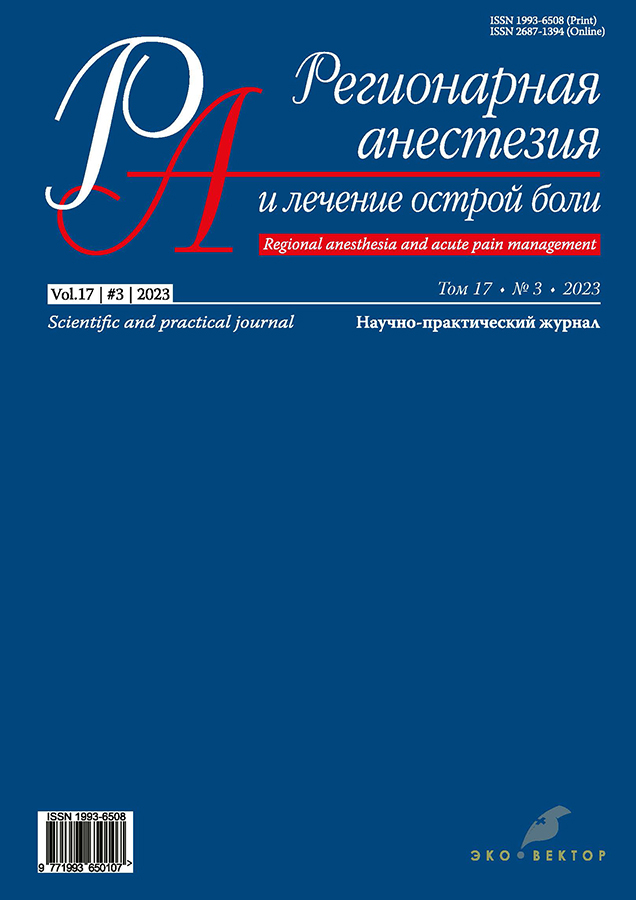Experiences with NeonFSC stress monitoring system for perioperative pain control in pediatric neurosurgery: a prospective observational study
- Authors: Tere V.A.1, Kulikov A.S.1, Lubnin A.Y.1, Satanin L.A.1
-
Affiliations:
- Burdenko National Medical Research Center for Neurosurgery
- Issue: Vol 17, No 3 (2023)
- Pages: 177-184
- Section: Original study articles
- Submitted: 18.12.2022
- Accepted: 25.08.2023
- Published: 23.11.2023
- URL: https://rjraap.com/1993-6508/article/view/119060
- DOI: https://doi.org/10.17816/RA119060
- ID: 119060
Cite item
Abstract
BACKGROUND: Prevention and treatment of pain is the primary goal of any anesthesiologist. This would entail meticulous assessment of pain, especially in children. However, there have been no comprehensive and objective methods developed to assess pain. Only a number of algometers based on the basic biology of the nociceptive system are currently used in clinical practice.
OBJECTIVE: Our aim was to document and analyze the experience of using NeonFSC stress monitoring system (LLC «VKO Fiziomed», Russia) in clinical practice for perioperative pain control in pediatric neurosurgery.
MATERIALS AND METHODS: We conducted a pilot prospective observational study that included 44 patients (18 girls and 26 boys) who were treated at the Burdenko National Medical Research Center for Neurosurgery at the age of 3 months to 18 years (Class I–II ASA). Patients received intraoperative fentanyl and postoperative administration of paracetamol round-the-clock and tramadol as needed. All patients underwent perioperative pain assessment using clinical data and pain assessment scales and the NeonFSC device. All patients were observed in the wake-up ward 3- minutes postextubation until transfer to the pediatric ward. Out of 44 patients, fourteen patients registered stress response in the NeonFSC monitoring system. Pain measured clinically using the Visual Analog Scale and FLACC were compared with NeonFSC data.
RESULTS: No signs of prolonged insufficient analgesia were observed in any patient intraoperatively. The CSP index, an integral indicator of the patient’s status, demonstrated adequate level of anesthesia and analgesia during the operations (from 0 to 18 points). We demonstrated that the CSP index and clinical assessment of pain were concordant in 10 (71%) cases. Four of these children reported moderate pain and six showed mild pain.
CONCLUSION: NeonFSC stress monitoring system is noninvasive and does not cause patient discomfort during recording. However, system indicators should be interpreted in the context of the overall clinical condition of the patient.
Keywords
Full Text
About the authors
Valentina A. Tere
Burdenko National Medical Research Center for Neurosurgery
Author for correspondence.
Email: valentinary@mail.ru
ORCID iD: 0000-0003-4247-8953
anesthesiologist-resuscitator
Russian Federation, MoscowAleksandr S. Kulikov
Burdenko National Medical Research Center for Neurosurgery
Email: akulikov@nsi.ru
ORCID iD: 0000-0002-2852-6544
SPIN-code: 1435-9285
MD, Dr. Sci. (Med.), senior researcher
Russian Federation, MoscowAndrei Y. Lubnin
Burdenko National Medical Research Center for Neurosurgery
Email: lubnin@nsi.ru
ORCID iD: 0000-0003-2595-5877
SPIN-code: 7224-2268
MD, Dr. Sci. (Med.), Professor
Russian Federation, MoscowLeonid A. Satanin
Burdenko National Medical Research Center for Neurosurgery
Email: LSatanin@nsi.ru
ORCID iD: 0000-0003-2051-1855
MD, Cand. Sci. (Med), neurosurgeon
Russian Federation, MoscowReferences
- Kulikov A, Tere V, Sergi PG, Bilotta F. Prevention and treatment of postoperative pain in pediatric patients undergone craniotomy: Systematic review of clinical evidence. Clin Neurol Neurosurg. 2021;205:106627. doi: 10.1016/j.clineuro.2021.106627
- Hansen MS, Brennum J, Moltke FB, Dahl JB. Pain treatment after craniotomy: where is the (procedure-specific) evidence? A qualitative systematic review. Eur J Anaesthesiol. 2011;28(12):821–829. doi: 10.1097/EJA.0b013e32834a0255
- Gottschalk A, Yaster M. The perioperative management of pain from intracranial surgery. Neurocrit Care. 2009;10(3):387–402. doi: 10.1007/s12028-008-9150-3
- Nemergut EC, Durieux ME, Missaghi NB, Himmelseher S. Pain management after craniotomy. Best Pract Res Clin Anaesthesiol. 2007;21(4):557–573. doi: 10.1016/j.bpa.2007.06.005
- Shay JE, Kattail D, Morad A, Yaster M. The postoperative management of pain from intracranial surgery in pediatric neurosurgical patients. Paediatr Anaesth. 2014;24(7):724–733. doi: 10.1111/pan.12444
- Tarasova NYu, Shmigel’skii AV, Lubnin AYu, Kulikov AS. Quantitative intraoperative monitoring of analgesia. Russian Journal of Anesthesiology and Reanimatology. 2020;3:27–36. (In Russ). doi: 10.17116/anaesthesiology202003127
- Ledowski T. Objective monitoring of nociception: a review of current commercial solutions. Br J Anaesth. 2019;123(2):e312–e321. doi: 10.1016/j.bja.2019.03.024
- Pop-Jordanova N, Pop-Jordanov J. Electrodermal Activity and Stress Assessment. Pril (Makedon Akad Nauk Umet Odd Med Nauki). 2020;41(2):5–15. doi: 10.2478/prilozi-2020-0028
- Amin R, Faghih RT. Physiological characterization of electrodermal activity enables scalable near real-time autonomic nervous system activation inference. PLoS Comput Biology. 2022;18(7):e1010275. doi: 10.1371/journal.pcbi.1010275
- Ledowski T, Pascoe E, Ang B, et al. Monitoring of intra-operative nociception: Skin conductance and surgical stress index versus stress hormone plasma levels. Anaesthesia. 2010;65(10):1001–1006. doi: 10.1111/j.1365-2044.2010.06480.x
- Sabourdin N, Arnaout M, Louvet N, et al. Pain monitoring in anesthetized children: First assessment of skin conductance and analgesia-nociception index at different infusion rates of remifentanil. Pediatr Anesth. 2013;23(2):149–155. doi: 10.1111/pan.12071
Supplementary files










